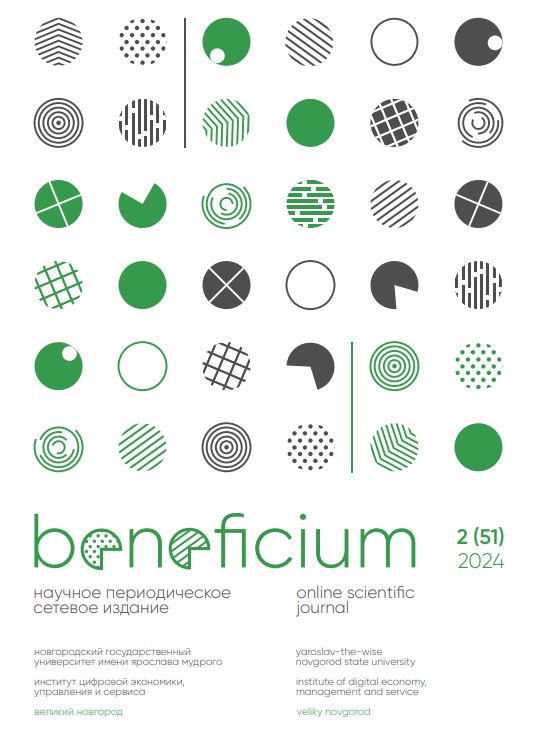INNOVATIVE DISCOURSE OF TELEVISION INDUSTRY DEVELOPMENT: VIRTUAL AND AUGMENTED REALITY TECHNOLOGIES
Abstract
At the present stage of digital transformation of society, more and more industries and enterprises are showing interest in virtual and augmented reality technologies (VR and AR), which, along with artificial intelligence, Big Data, and cloud technologies, are a promising direction for innovative development of all spheres of the economy. Virtual and augmented reality technologies are widely used in the creative industries. The purpose of the study is aimed at identifying and systematizing the functionality of VR and AR technologies for the digital television industry and its main actors: television companies, journalists and viewers. The article analyzes and summarizes the results of foreign and domestic research in the field of implementation and development of VR and AR technologies, characterizes the typological features of immersive technologies, examines the formats of immersive content, updates the requirements for the production of VR projects, identifies and summarizes the main problems and risks associated with the use of these technologies. Based on the research conducted, the author formulated recommendations for improving the practice of implementing and developing VR and AR technology in the digital television industry. The novelty of the research lies in the identification and systematization of the functionality of VR and AR technologies for the creative sector of the economy - the television industry. The article concludes that the functionality of VR and AR technologies has a significant impact on the digital transformation of the television industry, enriches it with innovative technologies, opens up new prospects and opportunities for television and journalists, radically changes the future of television companies, making their future more interesting and accessible for viewers, meet their needs and modern innovative trends of technological progress. The article may be useful to students, graduate students and doctoral students involved in the digital development of creative industries, as well as media researchers and media experts.
Keywords: virtual and augmented reality, virtual environment, immersive content, television industry, television channels, VR and AR devices, VR projects
References
- De La Pena N., Weil P., Llobera J. Immersive Journalism: Immersive Virtual Reality for the First-Person Experience of News // Presence Teleoperators & Virtual Environments. Vol. 19(4). Pp. 291-301. DOI:10.1162/PRES_a_00005
- Milgram P., Kishino F. A Taxonomy of Mixed Reality Visual Displays // IEICE Transactions on Information and Systems. 1994. Vol. E77-D(12-12). Pp. 1321-1329.
- Steven M. LaValle. Virtual Reality. Publisher: Cambridge University Press, 2017. 418 p.
- Dunas D.V. Mediapotreblenie «cifrovoj molodezhi» v Rossii [Media consumption of "digital youth" in Russia]. M.: Lomonosov Moscow State University, Faculty of Journalism, 2021. 406 p. (In Russ.).
- Vartanova E.L., Vyrkovsky A.V., Makeenko M.I., Smirnov S.S. Industriya rossijskih media: cifrovoe budushchee [Russian Media Industry: Digital Future]. M.: MediaMir, 2017. 160 p. (In Russ.).
- Vartanova E.L., Gladkova A.A., Lapin D.А., Samorodova E.V. Cifrovoe neravenstvo v sovremennom kommunikacionnom prostranstve Rossii [Digital Inequality in Russia's Modern Communication Space]. M.: Lomonosov Moscow State University, 2023. 187 p. (In Russ.).
- Krasheninnikova M.A, Supichenko A.S. Virtual'naya real'nost' v sovremennoj media-praktike [Virtual reality in contemporary media practice] // Proceedings of Voronezh State University. Series: Philology. Journalism 2020. Vol. 4. Pp. 104-110. (In Russ.).
- Malygina L.E. Virtual and Augmented Reality as Prospects in Television Promodiscourse Development. Verhnevolzhski philological bulletin. 2019. Vol. 1(16). Pp. 54-60. (In Russ.). DOI: 10.24411/2499-9679-2019-10312
- Osipovskaya E.A. Virtual Reality Technologies as a New Toolkit of Journalism // Vestnik NSU. Series: History and Philology. 2018. Vol. 6(17). Pp. 78-83. (In Russ.). DOI: 10.25205/1818-7919-2018-17-6-78-83
- Borodulin V.A. Sovremennye tekhnologii i effekt dopolnennoj real'nosti v televeshchanii [Modern technologies and augmented reality effect in television broadcasting] // Current problems of journalism: collection of works of young scientists. Tomsk. 2016. Vol. Pp. 40-42. (In Russ).
- Onuprienko K.A. “You Are There!”: Immersive Technologies in Journalism of the Information Society // Actual Issues of Modern Philology and Journalism. 2022. Vol. 1(44). Pp. 114-124. (In Russ.). DOI:36622/AQMPJ.2022.81.25.018
- Fomina A.N. Techno-economic Discourse on the Digital Transformation of the Television Industry // Voprosy Innovatsionnoy Ekonomiki. 2022. Vol. 12(4). Pp.2731-2748. (In Russ.). DOI: 18334/vinec.12.4.116627
- Vartanova E.L. Otechestvennaya teoriya media: osnovnye ponyatiya. Slovar' [Domestic Media Theory: Basic Concepts. Vocabulary.]. M.: Faculty of Journalism of Moscow State University: Moscow University Publishing House, 2019. 246 p. (In Russ.).
- Azuma R.T. A Survey of Augmented Reality // Teleoperators and Virtual Environments 6. 1997. Vol. 4. P. 355-
- Flew T. New Media: An Introduction. 4th ed. Publisher: Oxford University Press, 2014. 292 p.
- Malygina L.E. Virtual and Augmented Reality as Prospects in Television Promodiscourse Developmen // Verhnevolzhski Philological Bulletin. 2019. Vol. 1(16). Pp. 54-60. (In Russ.). DOI: 10.24411/2499-9679-2019-10312t
- Ivanova A.V. VR & AR Techologies: Opportunities and Application Obstaglies // Strategic decisions and risk management. 2018. Vol. 3. Pp. 88-107. (In Russ.). DOI: 10.17747/2078-8886-2018-3-88-107
- Kuda nas pogruzhayut immersivnye tekhnologii [Where Immersive Technologies Are Taking Us] (2019). Habr. (In Russ.). URL: https: habr.com/ru/companies/vtb/articles/463707/ (accessed on 11.02. 2023).
- Zamkov A.V. O virtual'nom rasshirenii mediareal'nosti [On the Virtual Extension of Media Reality] // Mediascope. 2017. 3. (In Russ.). DOI: 10.12731/2077-1770-2023-15-2-313-341
- Fomina A.N. Digital Transformation of the TV industry: Trends and Contexts // The Journal Creative economy. 2022. Vol. 16(11). Pp. 4363- (In Russ.). DOI: 10.18334/ce.16.11.11642
- Makarova N., Makhneva D. Virtual Reality Journalism. Changing of TV-reportage and the Professional Competences of a Journalist // RSUH/RGGU Bulletin: “Literary Teory. Linguistics. Cultural Studies”, Series. 2018. Vol. 1(34). Pp. 65-74. (In Russ.). DOI: 10.28995/2073-6355-2018-1-65-74
- Kolomiytseva E.Yu. Augmented Reality in Modern Media Communications: Development Prospects // Journalist. Social communications. 2023. Vol. 1(49). Pp. 29-33. (In Russ.).
- VR for News: The New Reality? (2017). Digital News Publications. URL: http://www.digitalnewsreport.org/publications/2017/vr-news-new-reality (accessed on 11.03.2023).
- Cherednichenko L.V., Chernykh A.V. Immersive Journalism: Concept and Functions // Humanitarian Scientific Bulletin. 2022. Vol. 6. Pp. 163-170. (In Russ.). DOI:5281/zenodo.6873518
- Urazova S.L., Kilpelyaynen E.S. Virtual and Media Reality: Trends and Forecasts of Media System Evolution // RUDN Journal of Studies in Literature and Journalism. 2018. Vol. 23(4). Pp. 410- (In Russ.). DOI:10.22363/2312-9220-2018-23-4-410-421
- Volkova I.I. Computer Games and New Media: Game Approach to Communications within Virtual Space // RUDN Journal of Studies in Literature and Journalism. Vol. 22(2). Pp. 312-320. (In Russ.). DOI: 10.22363/2312-9220-2017-22-2-312-320
- Vartanova E.L. Changing Russian Media Industry: Theoretical Approaches // Vestnik of Saint Petersburg University. Language and Literature. 2018. Vol. 15(2). Pp.186- (In Russ.). DOI: 10.21638/11701/spbu09. 2018.203
- Makeenko M.I., Vyrkovsky A.V. Potential for Non-institutionalized Creators of Entertainment and Educational Content to Influence the Audience // Vestnik Moskovskogo universiteta. Seriya 10. Zhurnalistika. 2021. Vol. 5. Pp. 74-99. (In Russ.). DOI: 10.30547/vestnik.journ.5.2021.7499
- Volkova I.I. Game paradigm of mass media research // European Social Science Journal. 2014. Vol. 5(2-44). Pp.228-231.
- Sidunova M.K. Tochki rosta immersivnoj zhurnalistiki v Rossii [Growth points of immersive journalism in Russia] // Mediasreda. 2020. Vol. 17. Pp. 53- (In Russ.). DOI: 10.24411/2070-0717-2020-10112
- Fomina A.N. Cloud TV Production in the Context of Innovative Development of the Digital TV Industry // Beneficium. 2023. Vol. 4(49). Pp. 74-84. (In Russ.). DOI: 10.34680/BENEFICIUM.2023.4(49).74-84
About the Author
Alexandra N. Fomina – Cand. Sci. (Economics); TV news correspondent, Branch of the Federal State Unitary Enterprise VGTRK State Television and Radio Broadcasting Company Bryansk, Bryansk, Russia. E-mail: fnv32@yandex.ru. SPIN РИНЦ 2613-1180. ORCID 0000-0001-6536-7135
For citation: Fomina A.N. Innovative Discourse of Television Industry Development: Virtual and Augmented Reality Technologies // Beneficium. 2024. Vol. 2(51). Pp. 88-97. (In Russ.). DOI: 10.34680/BENEFICIUM.2024.2(51).88-97









